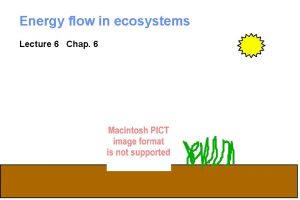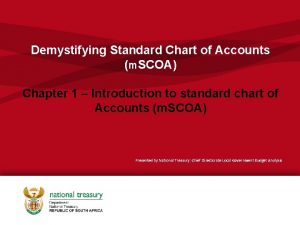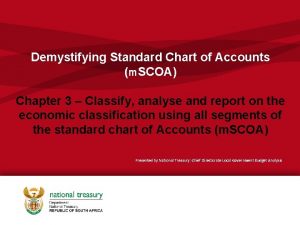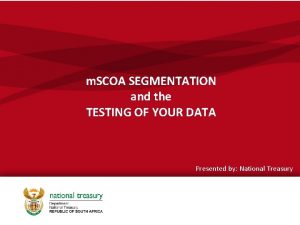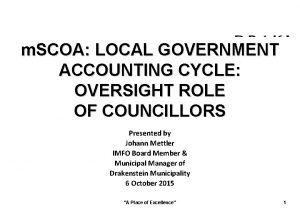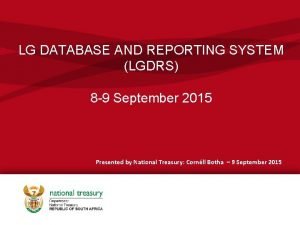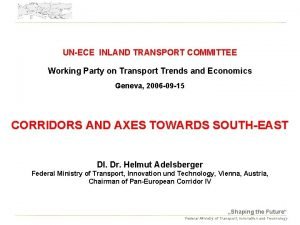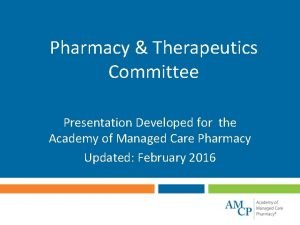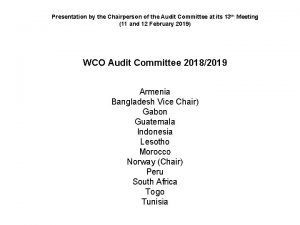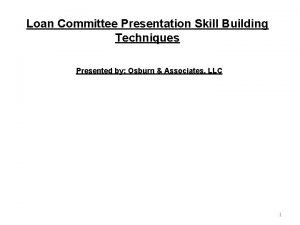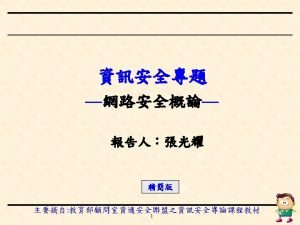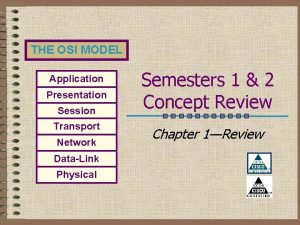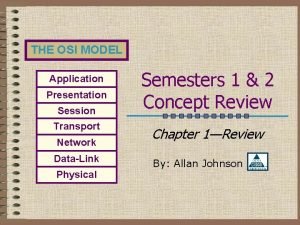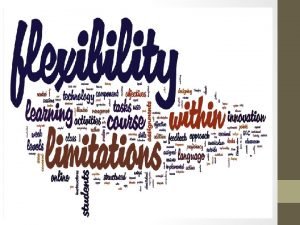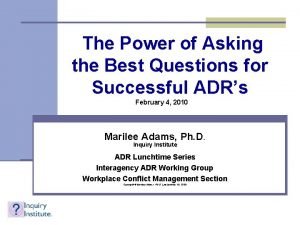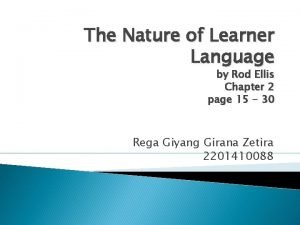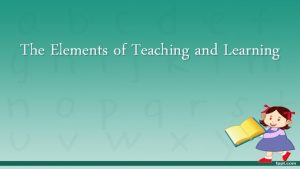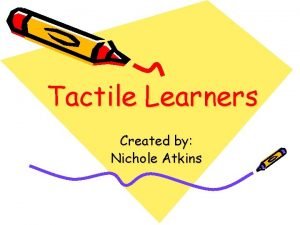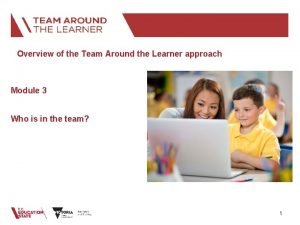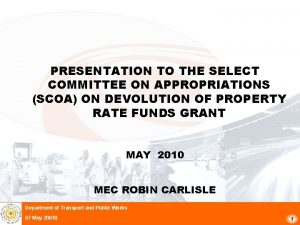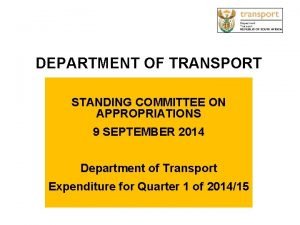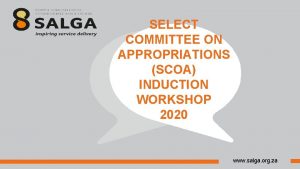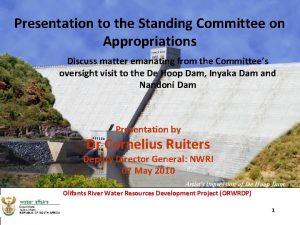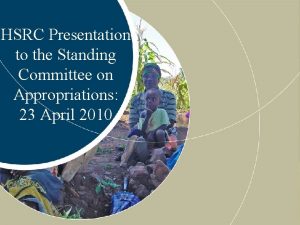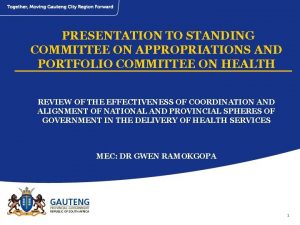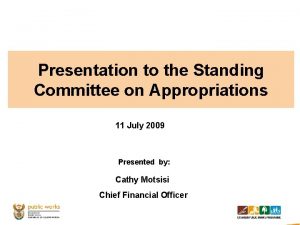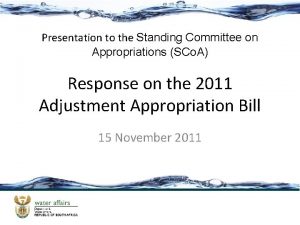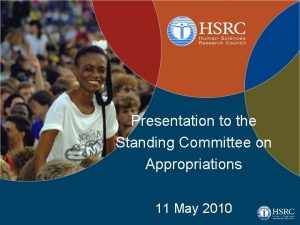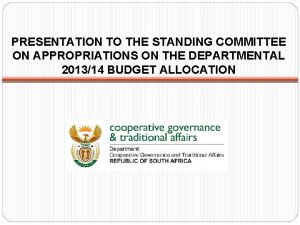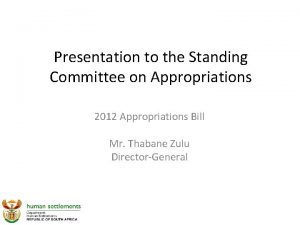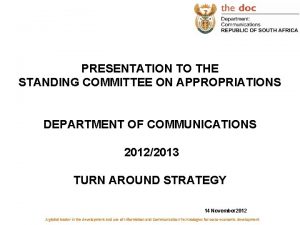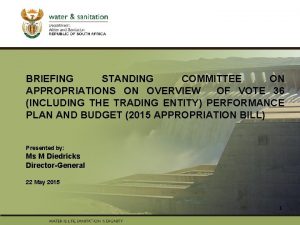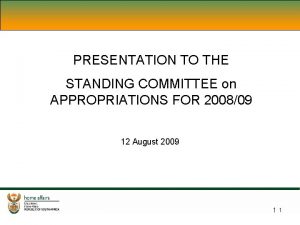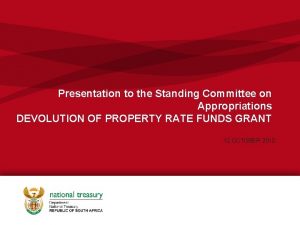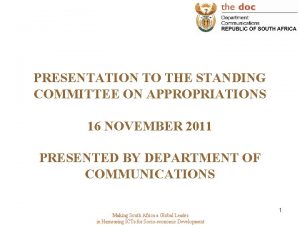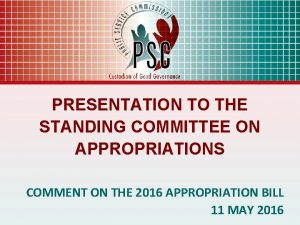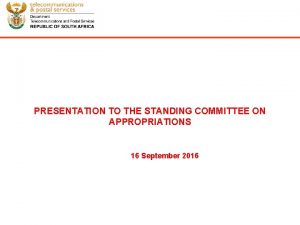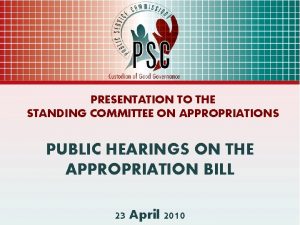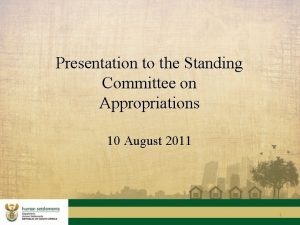LEARNER TRANSPORT PRESENTATION STANDING COMMITTEE ON APPROPRIATIONS SCOA


































- Slides: 34

LEARNER TRANSPORT PRESENTATION STANDING COMMITTEE ON APPROPRIATIONS (SCOA) 06 MARCH 2017

Presentation Outline 1) 2) 3) 4) 5) 6) 7) 8) Purpose Overview of the learner transport policy Coordination and monitoring Implementation and challenges Budgets and expenditure Evaluation of the programme General household survey 2016 Recommendation 2

Purpose To present to the Standing Committee on Appropriations progress made on the provision of learner transport. 3

OVERVIEW OF THE LEARNER TRANSPORT POLICY 4

Background Gazette for final comments Final Policy ere re h We a Implementation, M& E Draft Policy Cabinet Stakeholder engagement Cabinet Needs analysis FOSAD q The development of the learner transport policy was a response to a realization of a policy gap relating to the provision of the service. Challenges experienced included no services at all, unsafe and insecure methods that were used, uncoordinated services, unscrupulous operations and non-standardised operations. The policy was approved in June 2015 q The following process (with Department of Transport and the Department of Basic Education as a key partners-approved by Do. T’s Minmec and DBE’s CEM) was adopted: 5

Key Elements of the Policy q q q Institutional Framework for the implementation of learner transport; Learner transport planning; Learner transport safety and security; Criteria for learner transport beneficiaries; Service design for learner transport; Procurement of learner transport services; Remuneration of learner transport operators; Funding; Modal Integration; Universal Design; Law enforcement; and Monitoring and evaluation. 6

Policy objectives and principles Policy objectives Policy principles q To guide the implementation of a shared vision to improve access to quality education through a coordinated and aligned learner transport system. q To improve the planning and implementation of an integrated learner transport service. q To ensure an effective management of learner transport system. q To provide reliable, safe and secure transport for learners through cooperation and collaboration with law enforcement authorities. q Equity and redress q Quality and effectiveness q Operational safety and efficiency q Operational sustainability q Multi-modal integration 7

Desired Outcomes – Timeous delivery of service; – Rate of road accidents reduced; – A coordinated approach in relation to planning and implementation; – Learner transport operators that adhere to road traffic regulations; – Vehicle maintenance plan and technical support for emergencies; – Viable and sustainable operations; – Uniformity of services and tariff structure; and – A coherent performance monitoring system.

Scope of application q The policy applies for the transportation of learners from Grade R to 12 including learners with disabilities as defined by the SASA of 1996. q The policy should be understood within the context of inter -governmental relations. q Salient features include but are not limited to: q q q Service standards and procedures Route accessibility and design Safety specifications and vehicle design Capacity building and skills development, etc. Close collaboration and monitoring of the implementing agencies 9

Institutional Framework PROVINCE IMPLEMENTING DEPARTMENT Eastern Cape Transport Free State Transport Gauteng Education Kwa. Zulu-Natal Education Limpopo Education Mpumalanga Transport Northern Cape Transport North West Transport Western Cape Education

COORDINATION AND MONITORING OF LEARNER TRANSPORT 11

Institutional Arrangements Roles and responsibilities • The National Learner Transport Policy provides that learner transport planning and implementation require multisectoral coordination and approach where various government departments play significant roles. • This recognises that there are two departments at national and provincial level that are responsible for the provision of learner transport 12

POLICY IMPLEMENTATION PROGRESS Action Responsibility Progress Finalise Norms/Standards and Operational Guidelines for Learner Transport Department of Transport Completed Assessment of costing and funding for policy implementation Department of Transport In Progress Development of Standardised Model Contract to guide contracting authorities Department of Transport Completed Institute National Inter-Departmental Committee (NIDC) and facilitate the provincial interdepartmental Committees Department of Transport Completed Develop and implement a targeted National Learner Transport Road Safety Programme Department of Transport Provinces RTMC Ongoing Monitoring of the Implementation of Learner Transport Programmes DOT, DBE and provinces Ongoing Provinces 13

Institutional Framework… • The policy provides for the establishment of the National Inter-Departmental Committee (NIDC) to oversee the implementation of the learner transport programme. • The committee is comprised of National and Provincial Departments of Transport and Education. • The Committee meets on quarterly basis to receive progress on the implementation of the learner transport programme. • The committee reports to the Ministers of Basic Education and Transport. • To this end, the NIDC has been established. • Four (4) meetings were held for the 2016/17 financial year. • The 3 rd Quarter meeting for the 2017/18 financial year took place in January 2018. • Reports from the NIDC have been submitted to the Ministers. 14

IMPLEMENTATION AND CHALLENGES 2017/18 15

LEARNER TRANSPORT PROVISION 2014/152016/17 PROVINCE Number of % of Learners Transported Learners Transported Total demand Transported against target 2014 -15 2015 -16 2016 -17 Eastern Cape 94938 57176 60. 22% 98312 68576 69. 75% 111406 78061 70. 07% Free State 8053 100. 00% 7193 100. 00% 9736 11929 122. 52% Gauteng 75299 100. 00% 82971 82917 99. 93% 97114 109618 112. 88% Kwa. Zulu-Natal 85023 34814 40. 95% 81038 37223 45. 93% 71000 47747 67. 25% Limpopo 36123 18908 52. 34% 37272 21131 56. 69% 34321 100. 00% Mpumalanga 59354 100. 00% 59346 60231 101. 49% 60231 60119 99. 81% Northern Cape 23573 22641 96. 05% 27526 23640 85. 88% 27803 23684 85. 19% North West 61950 33334 53. 81% 52684 37164 70. 54% 52684 42281 80. 25% Western Cape 53950 100. 00% 57517 100. 00% 57416 58217 101. 40% TOTAL 498263 363529 78. 15% 503859 395592 81. 14% 521711 465977 93. 26%

LEARNER TRANSPORT PROVISION 2017/18 Province Total need 2017/18 Target No transported Q 3 % transported against the need EC 111 406 80552 100% 72% FS 9008 7095 79% GP 122801 110515 100% 90% KZN 90 000 47747 100% 53% LP 40268 37171 100% 92% MP 60231 100% NC 26877 24296 100% 90% NW 54059 42421 55849 132% 103% WC 59 408 58000 59408 102% 100% TOTAL 574 058 469 941 482864 101% 87%

KEY CHALLENGES Challenge Remedial measures Insufficient Funding of learner transport - Some provinces have provided additional funding in the 2017/18 adjustment budget. - Comprehensively evaluate the programme performance in terms of its efficacy/ efficiency and to determine funding requirements and mechanisms. The evaluation of the programme will assist in determining this. Location of function - Function is shared by Department of Transport and Education - Coordination and oversight of the function between two departments is a challenge - The evaluation would make recommendation on the proposed department that would be responsible for the function. Road safety - Strengthened law enforcement efforts; increase public engagement around road safety; involve citizens in debates around road safety and leading road safety campaigns (parents, learners, schools and operators). - Implementation of Focused National Learner Transport Road Safety Programme i. r. o awareness campaigns and enforcement - Develop and enforce driver and learner code of conduct 18

KEY CHALLENGES Challenge Remedial measures Rationalisation of schools - Provinces are assisted to ensure integration with other programmes to ensure that a common objective is achieved as these programmes can have an effect of increasing demand for transport, which results in increasing costs and inability to provide full coverage. - A national task team to assist provinces address rationalisation challenges has been set up. Infrastructure is an integral member of the committee to ensure that infrastructure matters are addressed timeously. Lack of uniformity in contracting and remuneration - Model contract documents and guidelines finalised and implemented. - The evaluation of the programme will provide solutions in terms of the appropriate remuneration model based on the performance reviews of the programme Inefficiencies in the provision of the programme - Address the transport of learners to schools of choice; - Address contracting obligations to add clause on contracting arrangement to address drop in learner numbers. 19

BUDGETS AND EXPENDITURE 20

FINANCIAL PERFORMANCE 2015/16 -2016/17 Budget and expenditure 2015 -16 PROVINCE NAME Budget allocation Actual expenditure Budget and expenditure 2016/17 Actual expenditure% Budget allocation Actual expenditure% Eastern Cape R 432, 000. 00 R 450, 618, 478. 00 104. 31% R 435, 000. 00 R 460, 706, 460. 13 105. 91% Free State R 40, 000. 00 R 9, 847, 939. 35 24. 62% R 40, 000. 00 R 50, 419, 489. 27 126. 05% Gauteng R 461, 000, 000. 00 100. 00% R 535, 896, 000. 00 R 681, 216, 162. 56 127. 12% Kwazulu Natal R 185, 976, 000. 00 R 52, 483, 535. 39 28. 22% R 186, 000. 00 R 68, 995, 857. 15 37. 09% Limpopo R 141, 103, 000. 00 R 50, 555, 000. 00 35. 83% R 226, 691, 000. 00 R 218, 555, 692. 86 96. 41% R 441, 622, 000. 00 R 484, 904, 664. 10 109. 80% R 455, 329, 000. 00 R 448, 334, 259. 75 98. 46% R 125, 359, 000. 00 R 28, 265, 500. 00 22. 55% R 121, 524, 000. 00 R 86, 528, 696. 44 71. 20% North West R 264, 466, 000. 00 R 248, 316, 721. 95 93. 89% R 272, 640, 000. 00 R 272, 139, 395. 26 99. 82% Western Cape R 270, 138, 000. 00 R 307, 514, 666. 00 113. 84% R 359, 755, 000. 00 R 329, 298, 018. 00 91. 53% R 2, 093, 506, 504. 79 88. 65% Mpumalang a Northern Cape TOTAL R 2, 361, 664, 000. 00 R 2, 632, 835, 000. 00 R 2, 616, 194, 031. 42 99. 37%

FINANCIAL PERFORMANCE Q 3 PROVINCE NAME ANNUAL BUDGET 2017/18 ADJUSTED BUDGET 2017/18 % OF EXPENDITURE TO DATE EC R 462 000. 00 R 475 303 232. 00 R 406 145 320. 85 85. 45% FS R 40 000. 00 R 50 000. 00 R 47 907 198. 52 95. 81% GP R 779 184 000. 00 R 624 198 125. 70 80. 11% KZN R 195 000 000. 00 R 195 734 014. 20 100. 38% LP R 274 223 000. 00 R 227 421 094. 35 82. 93% MP R 476 914 000. 00 R 329 872 610. 99 69. 17% NC R 125 310 000. 00 R 83 151 915. 68 66. 36% NW R 287 100 000. 00 R 145 572 329. 51 50. 70% WC R 380 047 000. 00 R 351 145 000. 00 R 264 394 028. 00 75. 29% R 3 019 778 000. 00 R 3 014 179 232. 00 R 2 324 396 637. 80 78. 47% Total 22

Evaluation of National Learner Transport in response to recommendations of the committee 23

EVALUATION OF THE SCHOLAR TRANSPORT PROGRAMME Ø The Standing Committee on Appropriations made the recommendations that an assessment of the efficacy of funding and a comprehensive evaluation of spending and implementation of the scholar transport programme be undertaken. Ø The purpose of this evaluation is to assess the implementation of the scholar transport programme, the efficacy of the funding model and whether learners are transported safely and on time. Additionally, this evaluation should show funding and expenditure impacts on the programme. Ø The evaluation will encompass the mandate and reach of the Scholar Transport Implementation Programme. The data will be reviewed from 2011/12 to 2016/17 financial years. Ø The service provider has been appointed, the steering committee has been constituted, data collection and interviews with different stakeholders is in progress and the project is expected to be completed in June 2018. .

STAKEHOLDERS IDENTIFIED • • National and Provincial Transport Departments; National and Provincial Education Departments; National Treasury (NT); Department of Performance Monitoring and Evaluation (DPME); • Statistics South Africa (STATSA); • Schools and other educational institutions; and • Other bodies SABOA, SACO, EE, and other NGOs.

Progress on the Evaluation of the Learner Transport Programme No Tasks and Milestones Timelines 1 Final Terms of Reference Completed 2 Project Steering Committee Completed 3 Appointment of service provider Completed 4 Development of Theory of Change March 2018 5 Literature Review February 2018 6 Data Collection and Analysis March-April 2018 7 Draft Report May 2018 8 Final Report June 2018 9 Submission of the Report to CABINET August 2018 26

General Household Survey 2016: Findings relating to Learner Transport 27

Out of school youth (age 7 -18) 900 000 8, 0 800 000 7, 0 Number 600 000 6, 0 500 000 4, 0 400 000 300 000 200 000 100 000 2002 2003 2004 2005 2006 2007 2008 2009 2010 2011 2012 2013 2014 2015 2016 Number 818 672 754 091 700 727 710 419 749 040 654 076 695 360 636 133 649 176 582 002 548 306 543 076 530 589 564 680 570 978 Proportions 6, 9 6, 3 5, 8 6, 1 5, 3 5, 6 5, 2 5, 3 4, 8 4, 5 4, 3 4, 6 3, 0 2, 0 1, 0 0, 0 Percentage 700 000

Main reasons given for not attending an educational institution Reason No money for fees Other Has completed education/satisfied with my level of education/do not want to study Education is useless or not interesting Failed exams Family commitment (e. g. child minding) He or she is working at home or business/job Unable to perform at school Pregnancy Not accepted for enrolment Disability Illness Too old/young Do not have time/too busy Got married Violence at school Difficulties to get to school (transport) School/education institution is too far Total 7 to 15 years 6. 8 15. 9 16 to 18 years 21. 4 14. 8 5. 9 6. 5 2. 8 2. 5 1 6. 3 2. 2 8. 6 28 7. 1 3. 7 1. 1 0 1. 2 0 0. 4 100 13 8. 3 7. 7 7. 4 7. 3 6. 5 3. 3 3 2. 2 2 1. 2 0. 7 0. 5 0. 4 0. 1 100

Percentage of 7 to 15 year olds walking to educational institutions for more than 30 minutes by province Province 2009 2010 2011 2012 2013 2014 2015 2016 EC 14. 8 16. 3 13. 0 13. 1 17. 3 13. 4 13. 9 11. 3 FS 10. 9 9. 8 7. 8 9. 7 7. 3 9. 0 8. 4 GP 12. 2 6. 0 5. 4 6. 9 3. 8 4. 5 5. 4 KZN 28. 0 26. 5 24. 6 23. 7 24. 0 23. 5 23. 4 21. 3 LP 11. 4 14. 8 12. 3 12. 2 9. 6 10. 2 10. 6 10. 4 MP 12. 6 12. 5 7. 8 9. 5 7. 6 7. 9 6. 0 8. 7 NW 10. 9 11. 6 14. 6 15. 5 12. 0 10. 1 11. 4 10. 8 NC 5. 8 3. 9 5. 4 9. 1 9. 8 9. 3 9. 4 7. 0 WC 3. 2 2. 6 3. 1 1. 8 3. 0 1. 3 1. 0 3. 8 National 15. 4 14. 8 13. 1 13. 5 12. 0 12. 2 11. 7

Percentage of 16 to 18 year olds by province walking to educational institutions for more than 30 minutes Province 2009 2010 2011 2012 2013 2014 2015 2016 EC 20. 8 21. 5 16. 5 22. 2 26. 8 19. 5 21. 8 16. 6 FS 13. 3 15. 0 14. 1 13. 4 12. 1 14. 8 10. 7 12. 7 GP 11. 8 7. 0 7. 3 11. 2 9. 2 10. 4 10. 0 9. 6 KZN 33. 8 34. 7 29. 7 30. 4 33. 1 33. 8 31. 6 LP 21. 4 21. 5 21. 2 19. 5 21. 1 20. 1 21. 6 14. 5 MP 21. 6 13. 8 11. 4 18. 4 14. 7 14. 6 14. 7 14. 5 NW 18. 5 19. 9 24. 6 22. 3 21. 9 12. 2 20. 6 15. 8 NC 7. 6 7. 3 8. 5 8. 2 6. 3 10. 7 14. 4 7. 2 WC 8. 4 4. 8 1. 5 2. 1 6. 4 0. 8 1. 5 10. 1 National 21. 3 20. 1 17. 9 19. 6 21. 0 19. 1 20. 2 17. 7

Summary • A lack of transport is not commonly reported as the reason for not attending school – No more than 3000 children (aged 5 -18) are reportedly not attending school due to remoteness or lack of transport. • Most learners walk to school (69%) • Walking long distances to school is most prevalent in KZN province • The percentage walking to school for more than 30 minutes has been decreasing over time – 7% of 5 -6 year-olds – 12% of 7 -15 year-olds – 18% of 16 -18 year-olds

RECOMMENDATION It is recommended that SCOA discusses the presentation on the implementation of learner transport. 33

Thank You 34
 Eager classification versus lazy classification
Eager classification versus lazy classification Difference between standing crop and standing state
Difference between standing crop and standing state Scoa chart of accounts
Scoa chart of accounts 8 scoa segments
8 scoa segments Scoa segments
Scoa segments Scoa accounting
Scoa accounting Lg upload portal
Lg upload portal Inland transport committee
Inland transport committee Sodium potasium pump
Sodium potasium pump Active transport
Active transport Passive transport vs active transport venn diagram
Passive transport vs active transport venn diagram Active vs passive transport venn diagram
Active vs passive transport venn diagram Unlike passive transport, active transport requires
Unlike passive transport, active transport requires Primary active transport vs secondary active transport
Primary active transport vs secondary active transport Bioflix activity membrane transport active transport
Bioflix activity membrane transport active transport Active and passive transport
Active and passive transport Bioflix membrane transport
Bioflix membrane transport P&t committee presentation
P&t committee presentation Audit committee presentation
Audit committee presentation Loan committee presentation
Loan committee presentation Finance committee presentation
Finance committee presentation Osi model
Osi model Subnetting worksheet
Subnetting worksheet Application presentation session transport network
Application presentation session transport network Brow presentation birth
Brow presentation birth Vertex presentation and cephalic presentation
Vertex presentation and cephalic presentation Your limitations as a student
Your limitations as a student Fyoutu
Fyoutu Learner portfolio
Learner portfolio Learner judger questions
Learner judger questions The nature of learner language
The nature of learner language Elements of teaching and learning
Elements of teaching and learning Facts about tactile learners
Facts about tactile learners Learner persona template
Learner persona template Team around the learner
Team around the learner

